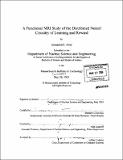| dc.contributor.advisor | Alan Jasanoff. | en_US |
| dc.contributor.author | Awai, Alexandra F | en_US |
| dc.contributor.other | Massachusetts Institute of Technology. Dept. of Nuclear Engineering. | en_US |
| dc.date.accessioned | 2006-11-07T12:21:44Z | |
| dc.date.available | 2006-11-07T12:21:44Z | |
| dc.date.copyright | 2005 | en_US |
| dc.date.issued | 2005 | en_US |
| dc.identifier.uri | http://hdl.handle.net/1721.1/34457 | |
| dc.description | Thesis (S.M. and S.B.)--Massachusetts Institute of Technology, Dept. of Nuclear Engineering, 2005. | en_US |
| dc.description | Includes bibliographical references. | en_US |
| dc.description.abstract | The aim of this research project was to study the neural substrates involved in processing rewarding stimuli. Evaluation of the magnitudes of reward is one of the fundamental aspects of goal directed behavior, and studies have shown that this process involves the midbrain dopamine system. Work by C. R. Gallistel has shown that the reward magnitude of electrical stimulation to structures within this system increases with increasing current and frequency. In this study, operant conditioning with intracranial self-stimulation of the medial forebrain bundle (MFB) was used to correlate the rewarding quality of a stimulus with variations of its current amplitude (Part 1) or electrical pulse frequency (Part 2). For Part 2, a saturation frequency, which is the point at which increasing stimulus frequency does not elicit a more vigorous operant response, were established for each of the responsive subjects. Functional magnetic resonance imaging (fMRI) with blood oxygenation level dependent (BOLD) contrast was then used to evaluate the brain activation in response to behaviorally characterized electrical stimuli. High resolution anatomical images revealed that subjects with electrode tips positioned within 1 mm of the midline of the MFB tended to demonstrate reward-seeking behavior. Timecourses were plotted for imaging voxels in areas exhibiting BOLD responses in Part 1 and Part 2. | en_US |
| dc.description.abstract | (cont.) In Part 1, the BOLD timecourse in the striatum/orbital cortex region - which has been implicated in reward processing - had different time-evolution characteristics than the central sinus, which is thought to reflect general hemodynamic responses to stimuli. Additionally, the activated regions were qualitatively similar for varying currents, but lower current amplitude led to a smaller percentage of active voxels. In Part 2, responses in the somatosensory/motor cortex and striatum with adjacent ventral forebrain, which are both thought comprise important reward processing circuitry, have similar BOLD responses for saturation and above saturation frequencies, but lower responses at below saturation frequencies. These results show that BOLD imaging can be utilized to isolate regions that code for the rewarding quality of MFB stimulation, rather than its sensory aspects. | en_US |
| dc.description.statementofresponsibility | by Alexandra F. Awai. | en_US |
| dc.format.extent | 61 leaves | en_US |
| dc.format.extent | 17065350 bytes | |
| dc.format.extent | 17246757 bytes | |
| dc.format.mimetype | application/pdf | |
| dc.format.mimetype | application/pdf | |
| dc.language.iso | eng | en_US |
| dc.publisher | Massachusetts Institute of Technology | en_US |
| dc.rights | M.I.T. theses are protected by copyright. They may be viewed from this source for any purpose, but reproduction or distribution in any format is prohibited without written permission. See provided URL for inquiries about permission. | en_US |
| dc.rights.uri | http://dspace.mit.edu/handle/1721.1/7582 | |
| dc.subject | Nuclear Engineering. | en_US |
| dc.title | A functional MRI study of the distributed neural circuitry of learning and reward | en_US |
| dc.title.alternative | fMRI study of the distributed neural circuitry of learning and reward | en_US |
| dc.type | Thesis | en_US |
| dc.description.degree | S.M.and S.B. | en_US |
| dc.contributor.department | Massachusetts Institute of Technology. Department of Nuclear Engineering | en_US |
| dc.contributor.department | Massachusetts Institute of Technology. Department of Nuclear Science and Engineering | |
| dc.identifier.oclc | 70715537 | en_US |

